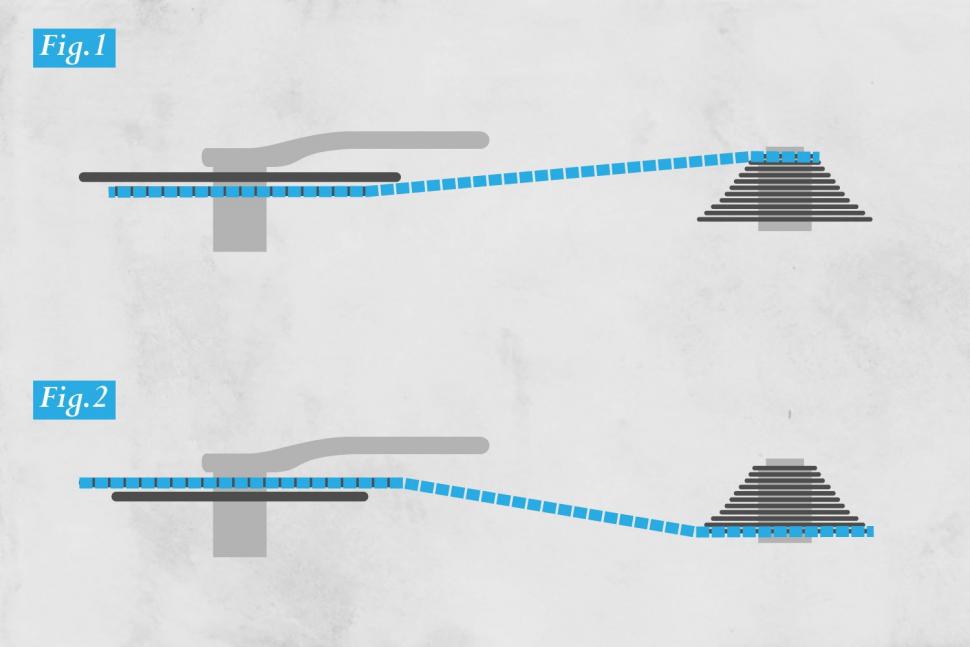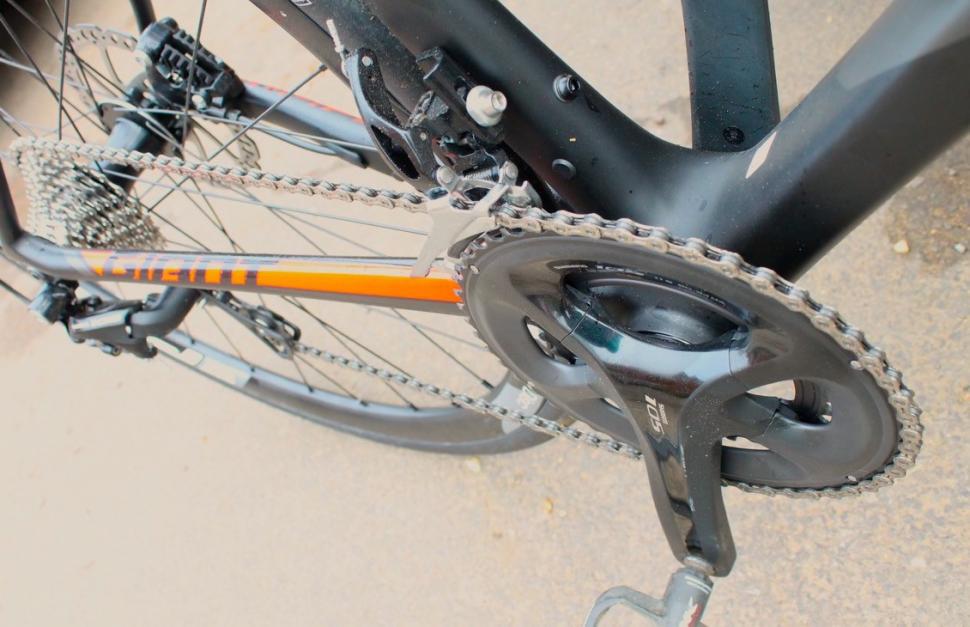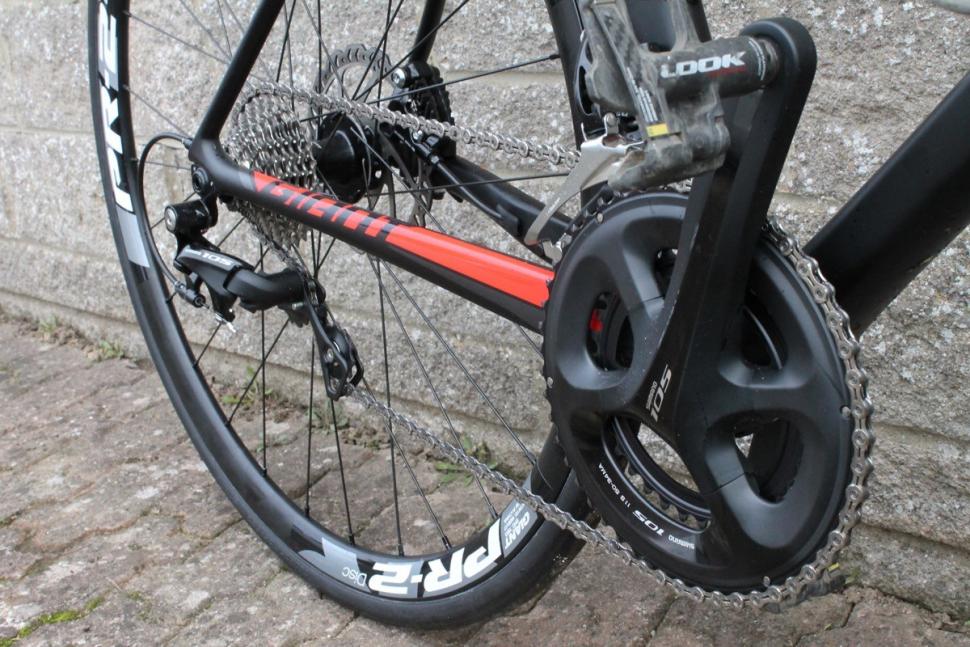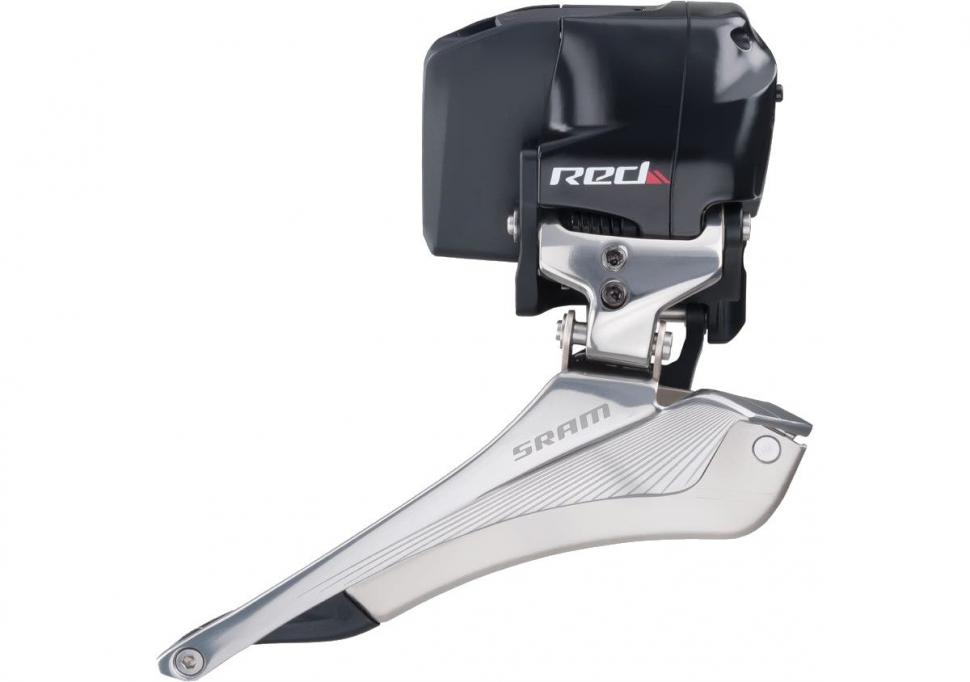- News
- Reviews
- Bikes
- Accessories
- Accessories - misc
- Computer mounts
- Bags
- Bar ends
- Bike bags & cases
- Bottle cages
- Bottles
- Cameras
- Car racks
- Child seats
- Computers
- Glasses
- GPS units
- Helmets
- Lights - front
- Lights - rear
- Lights - sets
- Locks
- Mirrors
- Mudguards
- Racks
- Pumps & CO2 inflators
- Puncture kits
- Reflectives
- Smart watches
- Stands and racks
- Trailers
- Clothing
- Components
- Bar tape & grips
- Bottom brackets
- Brake & gear cables
- Brake & STI levers
- Brake pads & spares
- Brakes
- Cassettes & freewheels
- Chains
- Chainsets & chainrings
- Derailleurs - front
- Derailleurs - rear
- Forks
- Gear levers & shifters
- Groupsets
- Handlebars & extensions
- Headsets
- Hubs
- Inner tubes
- Pedals
- Quick releases & skewers
- Saddles
- Seatposts
- Stems
- Wheels
- Tyres
- Health, fitness and nutrition
- Tools and workshop
- Miscellaneous
- Tubeless valves
- Buyers Guides
- Features
- Forum
- Recommends
- Podcast
feature
 crosschain.jpg
crosschain.jpgIs cross-chaining disastrous? Find out what the manufacturers say
Generations of cyclists have known that cross-chaining is A Bad Thing. It's one of those rules you get taught very early on. Ride with the chain on the small chainring (on the chainset, the component your pedals are attached to) and the smallest sprocket on the cassette (the cluster of cogs attached to the hub of the rear wheel) – as in fig 1 above – or on the large chainring and the largest sprocket – as in fig 2 – and anyone you're riding with is likely to alert you to the fact in seconds. People love to point it out.
But is cross-chaining really all that bad, or does it just get a bad rap? We asked some of the biggest component manufacturers for their views. You might be surprised at some of the things they said.
Read more: When should I replace my chain?
Shimano
The most efficient chain line occurs when the chain is running in a straight line. This minimises friction. When you run big-big you're pushing an uneven power transmission to the rollers, plates and bushings, especially at the points where the chain line alters (the points where the chain meets the sprocket and the chainring). This uneven load causes extra friction which increases the wear on the chain and longer term leads to less than optimum gear shifting.
For these reasons Shimano recommends avoiding extreme gear positions.
Ben Hillsdon, PR Officer, Shimano Europe
Shimano says you should avoid running the chain in this big-big combination (above).
Campagnolo
Cross-chaining is a practice to be avoided as it is less efficient than a straighter chainline (increased friction, less free motion of links etc).
We all might find ourselves cross-chaining during the heat of the battle during a race. However, we shouldn't make a habit out of it as there is generally a similar metric development gearing position available on a larger/smaller chainring.
Extreme chain crossing can add wear and tear on chainring and cassette teeth as the severe angle of the chain brings the external or internal part of the chain in direct contact with chainring/cassette teeth as opposed to a straight chainline which keeps friction to a minimum and limits contact to the rollers located on the axles of each chainlink.
Joshua Riddle, Press Manager, Campagnolo
Read our guide to understanding gears.
SRAM
At SRAM we love big-big. Amongst mechanics on the NORBA and Mountain Bike World Cup circuit (many years ago!), we called big-big the 'pro gear’, because professionals would ride it all the time, no matter what their mechanics told them. The same applies to pro road racers. They'll stay on the big ring as long as possible.
There are very good reasons to stay on the big chainring, even as far as the big sprocket:
• Chain management on rough terrain.
• Access to tallest gears without have to shift in front.
• Front shifts are slower than rear and much harder on the chain.
So we would encourage your readers to ride big-big if they like, as long as they don’t experience chain rasp on the front derailleur cage. SRAM 2x11 drivetrains, specifically the Yaw front derailleurs, are designed to accommodate this.
Very little efficiency is lost when cross-chaining. And in the case of big-big, minuscule efficiencies lost to cross-chaining are offset by efficiency gained because of larger bend radii for the chain. Better chain management and easier access to tall gears certainly outweigh any efficiency loss.
A few words on efficiency measurements. There are enormous differences between the efficiency measured on a loaded drivetrain and an unloaded drivetrain (what your hand feels when spinning the crank on a bike in a workstand). The sluggishness that cross chaining sometimes appears to cause on a bike in the stand disappears when the drivetrain is under load. It’s analogous to lubes in loaded and unloaded mechanical systems. Light oil generally feels better than heavy grease when a system is worked by hand, but when the system is loaded the heavier lube will be more efficient.
Similarly, cross-chaining is not a concern for premature component wear unless of course your chain is wearing through your front derailleur.
JP McCarthy, Road Product Manager, SRAM
Check out our beginner's guide to groupsets here.
FSA
In the last decade cross-chaining has become increasingly common with many people running the chain in the big chainring and big sprocket, especially with the advent of electronics which is much more permissive regarding cross-chaining.
This means that today's chains are subjected to much higher stresses than in the past. That’s why we decided to invest in the development of much stronger chains.
We have a stable supply of raw materials allowing us always to offer a product with a very high level of reliability and performance.
Here at FSA we understand well the importance of cross-chaining. Our latest introduction in this field is the 48/32 Adventure chainset. This is a new super compact standard that allows combination like 48/21 – 48/18. It’s a possible solution to avoid crossing because the chain works more linearly.
We will have this new range of chainsets available in 2017, from the carbon SL-K to our entry level Vero Pro.
Maurizio Bellin, General Manager, FSA
There's a range of views from the big brands, then; what do you think? Is cross-chaining perfectly acceptable? Or do you avoid it because of greater inefficiency and component wear and a higher chance of dropping your chain? Let us know your thoughts and experiences.
Mat has been in cycling media since 1996, on titles including BikeRadar, Total Bike, Total Mountain Bike, What Mountain Bike and Mountain Biking UK, and he has been editor of 220 Triathlon and Cycling Plus. Mat has been road.cc technical editor for over a decade, testing bikes, fettling the latest kit, and trying out the most up-to-the-minute clothing. He has won his category in Ironman UK 70.3 and finished on the podium in both marathons he has run. Mat is a Cambridge graduate who did a post-grad in magazine journalism, and he is a winner of the Cycling Media Award for Specialist Online Writer. Now over 50, he's riding road and gravel bikes most days for fun and fitness rather than training for competitions.
Latest Comments
- Ashok C 31 min 30 sec ago
The comment about the possible lack of mudguard mounts is absolutely brilliant! Cheers.
- hawkinspeter 1 hour 29 min ago
I used an iPump Twist a couple of times and it's not exactly designed for pushing a lot of air but didn't give me any issue apart from taking a...
- ktache 1 hour 56 min ago
I think most would be shocked by the death toll is at least four a day.
- hapaxlegomenon 2 hours 21 min ago
these look like they run super Duper narrow!
- hapaxlegomenon 2 hours 42 min ago
I agree on all points. In case you're wondering, this specific model runs a bit narrower than most other fizik SPD shoes that I've worn in the past...
- chrisonabike 3 hours 38 min ago
Ultimately the problem is humans. That is amplified by "mass motoring" - but even "professional drivers" mess up and kill....
- Miller 5 hours 9 min ago
Over on weight_weenies there's 310 pages of discussion on Light Bicycle so have a look there.
- Rendel Harris 5 hours 9 min ago
It's a thing... https://www.amazon.co.uk/Pilot-Carbon-Look-Decorative-Adhesive-Carbon/dp...
- nappe 5 hours 59 min ago
Went past this just after it had happened, straight road, just after a mini roundabout with traffic calming all the way down the road......





Add new comment
145 comments
It must be a slow news day in the cycling world to bring this one up again.
I run a single 53t carbon chainring with a 11 x26 cassette . Have that set up on my bikes for a few years now . No issue whatsoever it works just fine . I usually climbing when I’m in the bigger gears and I climb mostly out of my seat and it all works great . Climbed the ,alp d huez . Most of the climbs in Nice , climbed few mountains in Lucca back last October . Climbed in Barcelona and even the highlands of Scotland,north west gairloch area. I always since day 1 been on my single ring 53t .( 15 years ) ...the way to go if you have the power .
There is a difference between big/big and small/small.... small/small has much more torque generated than big/big... I have used big/big combo for DECADES despite the bemoaning of those that were "experts". My chains last longer than anyone I know and I never replace cogs or rings. Sure, I don't ride around big/big gut going there for a few minutes to crest a climb is no big deal. Sram got it EXACTLY right, pros stay in the BIG ring as long as possible.
1x here, so it's a given. Couldn't care less as long as it works and is quiet.
Oh, hello, old friend. Yes, three years on and it's still wrong to cross-chain. If you're having to do it you've probably got too big a gap between the number of teeth on your chainrings. That's why triple chainsets allow a better chain line and more even wear across the chain rings - and cassette - not to mention slower chain wear. Oh, and do fuck off, SRAM.
Funny how the comments match the makers products isn't it? You can getaway with cross chaining more nowadays as chains are narrower and more bendy (possibly being patly a result of being knackered more quickly as well) . Also cassettes are not much wider that they were in the days of a 6 speed block so things still work.
A chain is at its most efficient when run straight. Can't argue with that and any derailieur is actually the wrong use for a chain.
Like much in cycling, things like the SRAM yaw set up are designed to compensate for lack of skill or fitness. Chuck in marketing and the centuries old desire for something new and ideas change.
Whatever, bending a chain is wrong .
If you don't crosschain then you don't have the number of gears you think you have.
It's not as bad as cross-dressing or cross-contamination, so I think it's ok.
Ive been saying this for years, but manufacturers love to take your REPLACEMENT money, its no wonder SRAM is a fan, does it create wear, well why did they invent taller/narow wide teeth on chainring, at extream angles, those teeth chewing away at chain, chain chewing at teeth, chain chewing away on cassette, your call, Your money, SO all those older riders were wrong, & their cassettes werent as wide as now.
Says Sram, the company that just introduced special smaller chainrings and sprockets... they know that bigger rings ARE more efficient.
Hmm. What about Shimano GRX 1x? Time to update the article?
Oh god, this again? Why does road.cc keeps recycling old articles? I've seen this one at least five times now 8(
Dear Sram, yes fine for your pro riders they might well change the total drive system three times in one weekend of racing but not us mortals the cost is too much. In my younger days (in my sixties) I use to change at speed one ring up and one cassette cog down or reverse it depending on the level, up or downhill this way I doubled the gears on my road or off road bikes but never crossed ring if I could help! Yes keep the chain as straight as you can, just comment since Sram can sell my chains their way.
It's about time we had chainrings that moved in and out to completely avoid cross-chaining. Change gear and the chainring slides across to keep it in perfect alignment.
First!!!!! No, wait...
Road.cc, have you updated the content of this article since 12- and 13-speed came along? Would be useful to know what the manufacturers currently think of cross-chaining different systems. Thanks.
Pull the other one son. Its got bells on.
And again! At least Road.cc is doing it's bit for recycling.
Are you kink-shaming?
What a silly question! It says "UPDATED WED, JUN 29, 2022 08:10" right at the top, so it's clearly been completely redone. I bet they contacted the manufacturers again and just happened to get the same responses as in 2016.
I understand our muscular friend also rides a ~1.8kg complete bike of his own design which no doubt helps when grinding up the Alpe in 53/26
You and I may have read this piece every year but there are people new to cycling who haven't and who don't know what a sin it is to cross-chain.
Not slow news, its called, drip drip of your money.
but not as good as cross training.
But why cross chain anyway ? The ratios are duplicated elsewhere in the gears anyway so there's really no need.
I only do it by accident - I'd not do it intentionally.
Presumably bikes with longer chainstays are less affected by cross-chaining? It's surprising none of them mentioned that. Mine are reasonably long as my frame is based on a CX design.
That said, I tend to cross chain less than I used to. I try to use the little ring if I want to drop below big ring and 3rd biggest sprocket. I don't think I've ever used big ring - biggest sprocket. That does seem a bit wrong. Apparently there is a small wattage expense for extreme cross training. But I do get what peeps are saying about keeping it going in the big ring on short climbs.
I stopped smoking nearly forty years ago, so I don't have an actual fag packet to work it out on the back of, but here's the set up on my 'jazzy' bike:
When I'm on the big ring I go up the cassette as high as the 21T sprocket to find my preferred gear range, which on this bike is 62.8 inches in old money. Even here there is a degree of cross-chaining going on.
If I go barmy I could go to the 24(?)T sprocket to get a 55.0 gear (but why bother? I can do a double shift - crikey, these days even out of the saddle - and get a gear 10" below with far less chain deflection).
Going any higher up the cassette whilst on the big ring - initially to get a gear of 50.7" - would make me a silly sausage: on the 34T chain ring I have 52.8 & 47.2 either side of the centre of the cassette.
To go big-big I will get a 44.0" gear, but on the 34T chain ring I have 42.7 & 37.4 right where they're meant to be and almost perfectly aligned.
So, no, I don't cross-chain. Er, well, not if I can avoid it.
"At SRAM we love big-big. Amongst mechanics on the NORBA and Mountain Bike World Cup circuit (many years ago!), we called big-big the 'pro gear’, because professionals would ride it all the time, no matter what their mechanics told them." - JP McCarthy, Road Product Manager, SRAM.
Well given that the silly buggers you work for don't seem to make triple chainsets I hope you'll forgive me for not being swayed by this, JP
Gear calculator.JPG
@woldsman: that's an excellent discription of what you do and don't do, but less satisfactory is the why. You're not on your own there.
I don't think anyone's saying they cross-chain for the sake or love of it. The two camps seem to be 'I avoid cross-chaining' and 'I don't avoid cross-chaining - so what?'.
It's not as if cycling's received wisdom isn't thrown out of the window every now and then (fatter, lower pressure tyres being a recent rewriting of it), so just saying something's a bad idea doesn't float, in these days of easy measurement.
If you avoid cross-chaining: why?
ClubSmed, that's how multi chain rings have always worked, my ancient but lovely 3X7 XT seems to only have a range of 11 or 12 gears, and my 3X9 XTR maybe 14 or 15. Could be one of the reasons the 1X thing has taken off. I wish my next bike to have a Rohloff.
Doesn't chain length have something to do with this? When setting up the length of chain, Shimano say to set the chain on big big, without derailleur, the chain should be straight with a small V in a couple of links or straight and add a couple of links. If I were then to ride big big wouldn't my rear derailleur be very stretched out, almost horizontal, and in small small there is so much slack that the chain rubs on the chain on the jockey wheels. Less of an issue on doubles I guess.
I'm a serial cross-chainer and masher (I blame BMX growing up). I never think about it and no one has ever pointed it out. Maybe the guys I ride with are too polite.
Pages